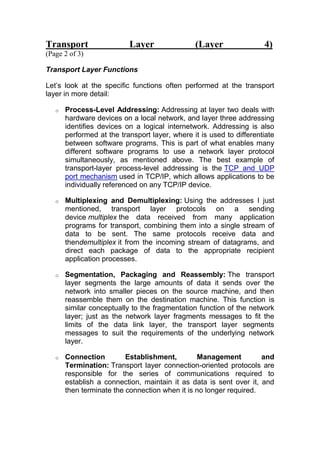
Transport layer
- 1. Transport Layer (Layer 4) (Page 2 of 3) Transport Layer Functions Let’s look at the specific functions often performed at the transport layer in more detail: o Process-Level Addressing: Addressing at layer two deals with hardware devices on a local network, and layer three addressing identifies devices on a logical internetwork. Addressing is also performed at the transport layer, where it is used to differentiate between software programs. This is part of what enables many different software programs to use a network layer protocol simultaneously, as mentioned above. The best example of transport-layer process-level addressing is the TCP and UDP port mechanism used in TCP/IP, which allows applications to be individually referenced on any TCP/IP device. o Multiplexing and Demultiplexing: Using the addresses I just mentioned, transport layer protocols on a sending device multiplex the data received from many application programs for transport, combining them into a single stream of data to be sent. The same protocols receive data and thendemultiplex it from the incoming stream of datagrams, and direct each package of data to the appropriate recipient application processes. o Segmentation, Packaging and Reassembly: The transport layer segments the large amounts of data it sends over the network into smaller pieces on the source machine, and then reassemble them on the destination machine. This function is similar conceptually to the fragmentation function of the network layer; just as the network layer fragments messages to fit the limits of the data link layer, the transport layer segments messages to suit the requirements of the underlying network layer. o Connection Establishment, Management and Termination: Transport layer connection-oriented protocols are responsible for the series of communications required to establish a connection, maintain it as data is sent over it, and then terminate the connection when it is no longer required.
- 2. o Acknowledgments and Retransmissions: As mentioned above, the transport layer is where many protocols are implemented that guarantee reliable delivery of data. This is done using a variety of techniques, most commonly the combination of acknowledgments and retransmission timers. Each time data is sent a timer is started; if it is received, the recipient sends back an acknowledgment to the transmitter to indicate successful transmission. If no acknowledgment comes back before the timer expires, the data is retransmitted. Other algorithms and techniques are usually required to support this basic process. o Flow Control: Transport layer protocols that offer reliable delivery also often implement flow control features. These features allow one device in a communication to specify to another that it must "throttle back" the rate at which it is sending data, to avoid bogging down the receiver with data. These allow mismatches in speed between sender and receiver to be detected and dealt with. o Relationship Between the Transport Layer and Network Layer o In theory, the transport layer and network layer are distinct, but in practice, they are often very closely related to each other. You can see this easily just by looking at the names of common protocol stacks—they are often named after the layer three and four protocols in the suite, implying their close relationship. For example, the name “TCP/IP” comes from the suite’s most commonly used transport layer protocol (TCP) and network layer protocol (IP). Similarly, the Novell NetWare suite is often called “IPX/SPX” for its layer three (IPX) and layer four (SPX) protocols. Typically, specific transport layer protocols use the network layers in the same family. You won't often find a network using the transport layer protocol from one suite and the network layer protocol from another. o The most commonly used transport layer protocols are the Transmission Control Protocol (TCP) and User Datagram Protocol (UDP) in the TCP/IP suite, the Sequenced Packet Exchange (SPX) protocol in the NetWare protocol suite, and the NetBEUI protocol in the NetBIOS/NetBEUI/NBF suite (though NetBEUI is more difficult to categorize.) http://www.tcpipguide.com/free/t_TransportLayerLayer4-3.htm
